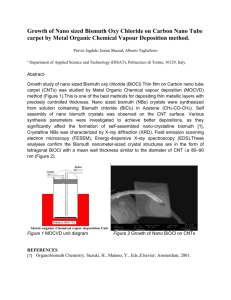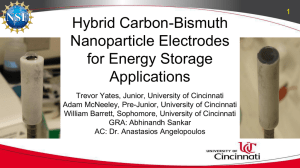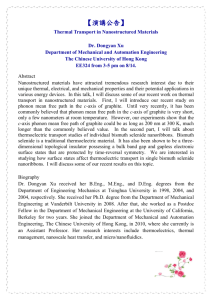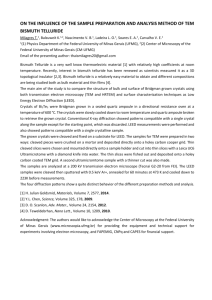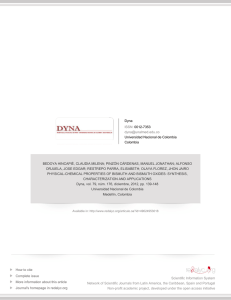Electrodeposition of Hexagonal Bismuth Oxide and its optical
advertisement
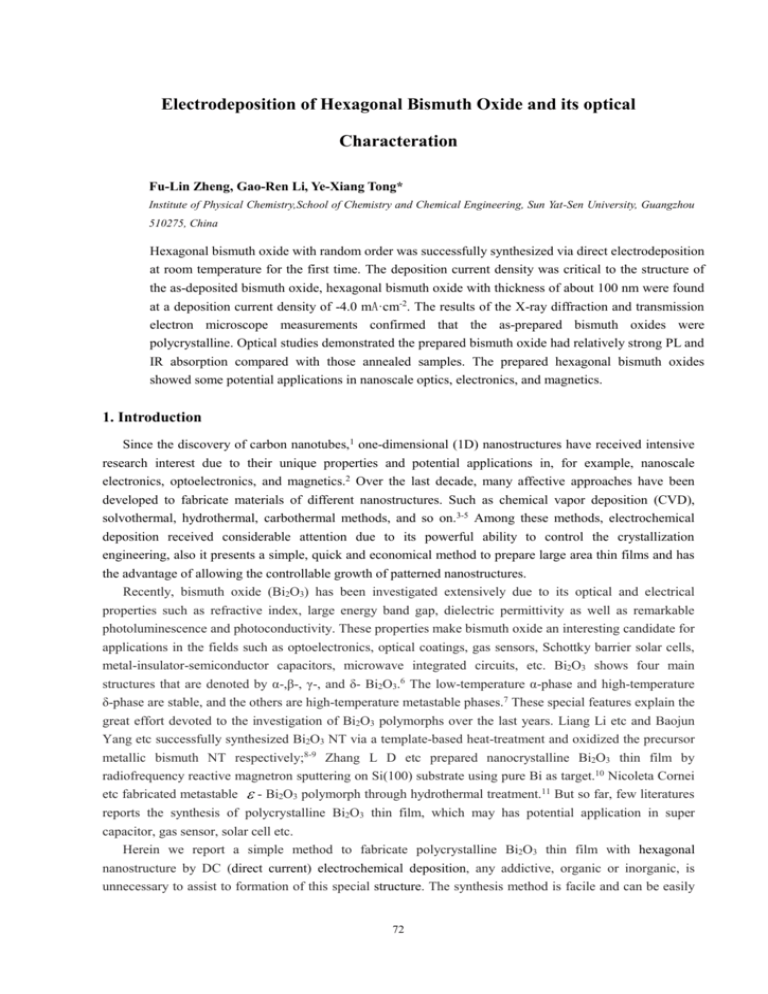
Electrodeposition of Hexagonal Bismuth Oxide and its optical Characteration Fu-Lin Zheng, Gao-Ren Li, Ye-Xiang Tong* Institute of Physical Chemistry,School of Chemistry and Chemical Engineering, Sun Yat-Sen University, Guangzhou 510275, China Hexagonal bismuth oxide with random order was successfully synthesized via direct electrodeposition at room temperature for the first time. The deposition current density was critical to the structure of the as-deposited bismuth oxide, hexagonal bismuth oxide with thickness of about 100 nm were found at a deposition current density of -4.0 mA·cm-2. The results of the X-ray diffraction and transmission electron microscope measurements confirmed that the as-prepared bismuth oxides were polycrystalline. Optical studies demonstrated the prepared bismuth oxide had relatively strong PL and IR absorption compared with those annealed samples. The prepared hexagonal bismuth oxides showed some potential applications in nanoscale optics, electronics, and magnetics. 1. Introduction Since the discovery of carbon nanotubes,1 one-dimensional (1D) nanostructures have received intensive research interest due to their unique properties and potential applications in, for example, nanoscale electronics, optoelectronics, and magnetics.2 Over the last decade, many affective approaches have been developed to fabricate materials of different nanostructures. Such as chemical vapor deposition (CVD), solvothermal, hydrothermal, carbothermal methods, and so on.3-5 Among these methods, electrochemical deposition received considerable attention due to its powerful ability to control the crystallization engineering, also it presents a simple, quick and economical method to prepare large area thin films and has the advantage of allowing the controllable growth of patterned nanostructures. Recently, bismuth oxide (Bi2O3) has been investigated extensively due to its optical and electrical properties such as refractive index, large energy band gap, dielectric permittivity as well as remarkable photoluminescence and photoconductivity. These properties make bismuth oxide an interesting candidate for applications in the fields such as optoelectronics, optical coatings, gas sensors, Schottky barrier solar cells, metal-insulator-semiconductor capacitors, microwave integrated circuits, etc. Bi2O3 shows four main structures that are denoted by α-,β-, γ-, and δ- Bi2O3.6 The low-temperature α-phase and high-temperature δ-phase are stable, and the others are high-temperature metastable phases.7 These special features explain the great effort devoted to the investigation of Bi2O3 polymorphs over the last years. Liang Li etc and Baojun Yang etc successfully synthesized Bi2O3 NT via a template-based heat-treatment and oxidized the precursor metallic bismuth NT respectively;8-9 Zhang L D etc prepared nanocrystalline Bi2O3 thin film by radiofrequency reactive magnetron sputtering on Si(100) substrate using pure Bi as target.10 Nicoleta Cornei etc fabricated metastable - Bi2O3 polymorph through hydrothermal treatment.11 But so far, few literatures reports the synthesis of polycrystalline Bi2O3 thin film, which may has potential application in super capacitor, gas sensor, solar cell etc. Herein we report a simple method to fabricate polycrystalline Bi2O3 thin film with hexagonal nanostructure by DC (direct current) electrochemical deposition, any addictive, organic or inorganic, is unnecessary to assist to formation of this special structure. The synthesis method is facile and can be easily 72 extended to the fabrication of other metal oxide. 2. Experimental Section A simple three-electrode cell was used. The reference electrode was a saturated calomel electrode (SCE) which was connected to the cell with a double salt bridge system, a graphite rod with about 4.0 cm2 was used as a auxiliary electrode, the working electrode was a pure titanium foil. Before depositions, the titanium foil was cleaned ultrasonically in 0.1 M HCl, distilled water, and acetone and then rinsed in distilled water again. The electrolyte was Bi(NO3)3-HNO3 solution. Cyclic voltammetry was employed to study the electrochemical reactions relevant. The electrodeposition current was maintained at -4.0 mA for around 60 min. Finally, the deposited films were removed from the electrolyte and rinsed with distilled water and acetone. Scanning electron microscopy (SEM, JSM-6330F) was used to image the prepared films. Transmission electron microscopy equipped with selected area electron diffraction (SAED) was used for micro-structure observation. The X-ray diffraction (XRD) (D/Max-IIIA, Rigaku, Japan) (Cu kα radiation, = 0.15405980 nm) was used to determine the structures of the samples. X-ray Photoelectron Spectroscopy (XPS) was used for surface analysis. IR and Photoluminescence property of the as-prepared film was also investigated on a Spectrofluorophotometer (RF-5301PC) and a UV-Vis-NIR Spectrophotometer (UV-3150) respectively. 3. Result and Discussion The cyclic voltammogram of a Pt electrode in 0.005 M Bi(NO3)3 + 1 M HNO3 at room temperature is shown in Figure 1. Bi(NO3)3 dissolved in HNO3 will form BiO+, peak I is due to the reduction of Bi(NO3)3 corresponds to BiO+ + 2H+ + 3e → Bi + H2O at about -0.05 V, which shift positive than our previous study (-0.27 V) owe to the addictive of tartaric acid in our previous system. When bismuth was reduced on the surface of the substrate, nanosize bismuth was first formed which served as an electron bath.16 Threr were large number of electron on the surface of these electron baths, as a result, their had relatively high reactive activity, so these electron baths would reacted with H2O to form bismuth oxide. XRD pattern of the prepared Bi-Bi2O3 film was shown in Figure 2. It proved that the deposited bismuth oxide was polycrystalline. But after heat treatment for 4 hours at 250 ℃, the as-deposited Bi2O3 film shown a prefer growth direction along (111), which was revealed in Figure 2(b). The peaks marked with asterisk came from the titanium substrate, and peaks marked with square were attributing to titanium oxide which was caused by the oxidation of the substrate. The microstructure of deposits was investigated through scanning electron microscope. 73 Ⅰ 0.0002 0.0001 0.0000 I/A -0.0001 -0.0002 -0.0003 Ⅱ -0.0004 -0.0005 0.2 0.1 0.0 -0.1 -0.2 E / V vs SCE Figure 1. Cyclic voltammogram of the Pt electrode at 20 mV/s in solution of: 0.005 M Bi(NO 3)3 + 1 M HNO3 (200) Intensity (a.u) (111) As shown in Figure 3(a), it can be observed that the surface of the prepared Bi2O3 film was composed of numerous nano-sized hexagons. Further examination of the hexagonal nanostructure was carried out, and the SEM with higher magnification was shown in Figure 3(b). The width of every edge of the hexagon is about 500 nm, and the thickness is about 100 nm. From the SAED and HRTEM studies, which was shown in Figure 4(b), it is inferred that the as-deposited bismuth oxide was polycrystalline. The result was in good agreement with the XRD measurement. * * (311) * □ □ (b) (220) * (a) 20 40 60 2 Theta Figure 2. XRD pattern of the as-prepared film: (a) before anneal, (b) after anneal at 250 ℃ for 4 h (a) (b) Figure 3. SEM images of the as-prepared film at different magnification: (a) 5000×, (b)120,000× 74 (a) (b) Figure 4. TEM image (left) and HRTEM image with SAED pattern inset (right) of the hexagon bismuth -bismuth oxide Surface analysis of the prepared Bi2O3 was carried out using X-ray photoelectron spectroscopy (XPS, ESCALAB 250), and the XPS spectra of bismuth 4f is shown in Figure 5(a). The Bi 4f7/2 peak at about 159.1eV and Bi 4f5/2 at about 164.4 eV can be observed. Both are close to those that have been reported of Bi2O3.10 In Figure 5(b), it shows a broad O1s peak at approximately 532.3 eV. Shoulders of the Bi4f7/2 peaks related to either bivalent12 or tetravalent13 or pentavalent 14 states in bismuth oxide was not observed as expected, this result indicated that the surface of the prepared films were pure Bi2O3, and there were not any suboxide (BiO) and superoxide (Bi2O5) phases. Bif7/2 (a) 158 160 162 164 Relatively Intensity (a.u) Relatively Intensity (a.u) Bif5/2 156 O1s (b) 166 168 525 530 535 540 Binding energy (eV) Binding energy (eV) Figure 5. XPS pattern of the as-deposited film (a) Intensity (a.u) (b) (c) 300 (d) 400 Wavelength (nm) Figure 6. PL spectra of the as-deposited film (a) excitation spectrum, (b) emission spectra The PL properties of the as-prepared film were investigated, and a room-temperature PL spectrum is shown in Figure 6. A peak at approximately 351 nm was observed from the excitation spectrum, Figure 6(a). 75 And on the emission spectra, it shows a peak at around 385 nm, when used an excitation wavelength of 351 nm as confirmed by the excitation spectra Figure 6(b). The result proved that the prepared bismuth oxide showed a relatively high PL property though the corresponding mechanism needed to be further investigated. From the XRD result in Figure 3(a), the prepared film was polycrystalline, it may exist many dislocations such as oxygen vacancies and interstitial bismuth, and this can enhance the possibility of photon excitation, which may lead to a photoluminescence phenomenon. Annealed samples were also investigated, the result shown in Figure 6 (c) and (d), the peaks in excitation and emission spectra were neglectable. IR property of the prepare sample was investigated. Figure 7 shown IR spectra of the deposited films. Samples before or after anneal have the same absorption positions but different intensity. On Figure 7(a), absorption bands between 400-600 cm-1 due to vibrations of Bi-O bonds,15 besides, a very strong absorption band at about 1386 cm-1 and a broad band at about 3413 cm-1 were also observed. As the prepared bismuth oxide was polycrystalline proved by XRD and SAED, we expected there may exist different kinds of Bi-O bonds in the deposited layer. And no other element was found in EDS pattern, so this two absorption band may attribute to the other kinds of vibrations of Bi-O which caused by the interaction of between the Bi-O bonds and their other surrounding. The IR spectra revealed that the polycrystalline bismuth oxide have strong IR absorption, which may have optimal potential application in future. In addition, Figure 7 reveals that polycrystalline bismuth oxides have much stronger absorption intensity compared with the annealed sample, and this result indicate that polycrystalline bismuth oxide may have potential applications on nanoscale optics such as gas sensor optoelectronics, optical coatings, etc. Transmittance (a.u) (a) (b) 500 1000 1500 2000 2500 3000 3500 -1 Wavenumber (cm ) Figure 7. IR spectra of the as-deposited film: (a) before anneal, (b) after anneal at 250 ℃ for 4 h 4. Conclusion Hexagonal bismuth oxide nanostructure with a thickness of approximately 100 nm was successfully synthesized via direct electrodepostion. The films were which show a relatively strong photoluminescence and IR absorption. The prepared hexagonal bismuth oxide may have future applications in nanoscale optics, electronics, and magnetics. 76 5. Acknowlegment We appreciate this work was supported by the Natural Science Foundations of China, the Natural Science Foundations of Guangdong Province, and the Foundations of Innovation Research for College Students of Sun Yat-Sen University. References (1) Iijima, S. Nature 1991, 354, 56. (2) Morales, A. M.; Lieber, C. M. Science 1998, 279, 208. (3) Gao, P.X.; Ding, Y.; Wang, Z.L. Nano Lett. 2003, 3, 1315. (4) Hu, H. M.; Mo, M. S.; Yang, B. J.; Shao, M.W.; Zhang, S. Y.; Li, Q.W.; Qian, Y.T. New J. Chem. 2003, 27, 1161. (5) Liu, J.G..; Zhang, Z. J.; Zhao, Y.; Su, X.; Liu, S.; Wang, E. Small 2005, 1, 310. (6) Shuk, P.; Wiemhöfer, H.-D.; Guth, U.; Göpel, W.; Greenblatt, M. Solid State Ionics 1996, 89, 179. (7) Leontie, L.; Caraman, M.; Visinoiu, A.; Rusu, G. I. Thin Solid Films 2005, 473, 230. (8) Liang L; Yang, Y.W.; Li, G.H.; Zhang, L.D. small 2006, 4, 548. (9) Yang, B.j.; Mo, M.S.; Hu, H.M.; Li, C.; Yang, X.G.; Li, Q.W.; Qian Y.T. Eur. J. Inorg. Chem. 2004, p 1785. (10) Fan, H.T.; Pan, S.S.; Teng, X.M.; Ye, C.; Li, G.H.; Zhang L.D. Thin Solid Films 2006, 513, 142. (11) Cornei, N.; Tancret, N.; Abraham, F.; Mentre, O. Inorganic Chemistry 2006, 45, 13. (12) Dharmadhikari, V.S.; Goswami, A. J. Vac. Sci. Technol. 1983, 1, 383. (13) Morgan, W.E.; Stec, W.J.; Van Wazer, J.R. Inorg. Chem. 1973, 12, 953. (14) Barreca, D.; Morazzoni, F.; Rizzi, G.A.; Scotti, R.; Tondello, E. Phys. Chem.Chem. Phys. 2001, 3, 1743. (15) Baia, L.; Stefan, R.; Kiefer, W.; Simon1, S. J. Raman Spectrosc. 2005, 36, 262 (16) Zhang, L.X.; Wang, E.G.; Xue, Q.K.; Zhang, S.B.; Zhang, Z.Y. Phys. Rev. Lett. 2006, 97, 126103 电沉积六边形的氧化铋和其光学性能表证 郑富林 李高仁 童叶翔* 中山大学化学与化学工程学院物化所 中国广州 510275 【摘要】 用电沉积方法在室温首次制备出六边形的Bi2O3,沉积的电流密度对沉积膜的形貌结构有很大的影 -2 响,在 -4.0 mAcm 的沉寂电流六边形的Bi2O3,X-射线粉末衍射和电子衍射都证实所沉积的Bi2O3 膜 是多晶态。光学性质的测量表征可以表明,与晶化之后的沉积膜相比,多晶态的Bi2O3 有相对强的红外 吸收和一定的荧光现象。其这些光学特征将使得多晶态三氧化二铋在纳米光学,电学,磁学等方面有 很大的应用前景。 关键字:电沉积 纳米 氧化铋 红外 荧光 77
